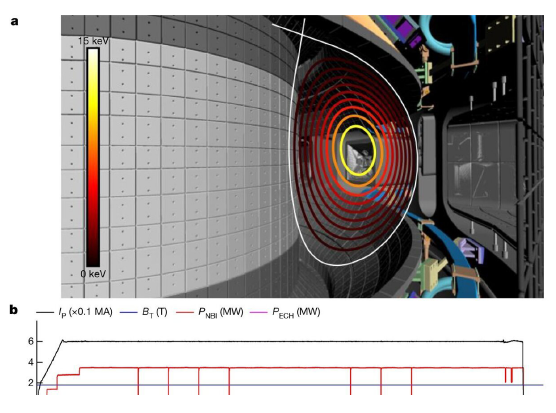博文
研究人员在一亿开尔文的温度下进行了20秒的核聚变
 精选
精选
||
研究人员在一亿开尔文的温度下进行了20秒的核聚变
诸平
Tokamak geometry and the parameter evolution of a FIRE mode. a, The plasma configuration of a FIRE mode in KSTAR. The colour of the lines indicates the ion temperature in kiloelectronvolts, with 10 keV corresponding to ≈120 million kelvin. b–i, The time evolution of main physics and engineering parameters (shot 25860). b, The plasma current (Ip), toroidal magnetic field strength at the magnetic axis (BT), neutral beam injection power (PNBI) and electron cyclotron resonance heating power (PECH). c, The energy confinement enhancement factors relative to the ITER89P and the IPB98(y,2) scaling law (H89 and H98y2) and stored plasma energy (WMHD). d, The line-averaged electron density (ne) and line-averaged fast-ion density from NUBEAM calculations (nfast). e, The central ion and electron temperature (Ti,0 and Te,0). f, The Dα emission intensity. g, The loop voltage. h, The internal inductance (li), normalized beta (βN) and the magnetic fluctuations detected by Mirnov coils. i, The carbon line radiation intensity from C2+→3+. Credit: Nature (2022). DOI: 10.1038/s41586-022-05008-1
据物理学家组织网(Phys.org)2022年9月8日刊发的鲍勃·伊尔卡(Bob Yirka)撰写的报道,韩国多个机构的一个研究小组与美国普林斯顿大学(Princeton University)的两名同事和美国哥伦比亚大学(Columbia University)的一名同事合作,在核聚变作为能源的开发方面取得了新的里程碑。他们产生了一个产生一亿开尔文(100 million Kelvin)温度并持续20秒的核聚变反应(Researchers generate fusion at 100 million Kelvin for 20 seconds)。相关研究结果于2022年9月7日已经在《自然》(Nature)杂志网站发表——H. Han, S. J. Park, C. Sung, J. Kang, Y. H. Lee, J. Chung, T. S. Hahm, B. Kim, J.-K. Park, J. G. Bak, M. S. Cha, G. J. Choi, M. J. Choi, J. Gwak, S. H. Hahn, J. Jang, K. C. Lee, J. H. Kim, S. K. Kim, W. C. Kim, J. Ko, W. H. Ko, C. Y. Lee, J. H. Lee, J. H. Lee, J. K. Lee, J. P. Lee, K. D. Lee, Y. S. Park, J. Seo, S. M. Yang, S. W. Yoon, Y.-S. Na. A sustained high-temperature fusion plasma regime facilitated by fast ions. Nature, 2022, 609: 269–275. DOI: 10.1038/s41586-022-05008-1. Published: 07 September 2022. https://www.nature.com/articles/s41586-022-05008-1. 在此论文中,该研究小组描述了他们的工作以及未来几年的计划。
参与此项研究的有来自韩国核聚变能源研究所(Korea Institute of Fusion Energy)、韩国首尔国立大学(Seoul National University)、韩国科学技术高级研究院(Korea Advanced Institute of Science and Technology)、韩国高丽科技大学(Korean University of Science and Technology)、韩国汉阳大学(Hanyang University);美国普林斯顿等离子体物理实验室(Princeton Plasma Physics Laboratory, Princeton, NJ, USA)、普林斯顿大学(Princeton University)以及美国哥伦比亚大学(Columbia University)的研究人员。
在过去几年中,科学家们一直试图在发电厂(power plants)内创造可持续的核聚变反应( fusion reactions),作为产生热量转换为电能的手段。尽管取得了重大进展,但主要目标仍未实现。研究这一问题的科学家发现,很难控制核聚变反应——最轻微的偏差都会导致不稳定,阻止反应继续。最大的问题是如何处理产生的数百万度的热量。当然,这些材料不能容纳那么热的等离子体,所以它是用磁悬浮的。
有两种方法被设计出来:一种被称为边缘传输屏障(edge-transport barrier),它以防止等离子体逃逸的方式塑造等离子体。另一种方法被称为内部传输势垒(internal transport barrier),这是在韩国超导托卡马克高级研究中心(Korea's Superconducting Tokamak Advanced Research Center)新研究地点工作的研究人员所使用的方法。它的工作原理是在等离子体中心附近形成一个高压区域,使其处于受控状态。
研究人员指出,与其他方法相比,使用内部传输屏障会产生密度更高的等离子体,这就是他们选择使用它的原因。他们指出,密度越高,越容易在核心附近产生更高的温度。它还导致等离子体( plasma)边缘附近的温度降低,这对用于密封的设备来说更容易。
在该设施的最新测试中,该团队能够产生高达一亿开尔文的热量,并使核反应持续20秒。其他团队要么产生了相似的温度,要么保持了相似的反应时间,但这是第一次在一个反应中实现这两种反应。
研究人员下一步计划对他们的设施进行改造,以利用他们在过去几年的研究中所学到的知识,例如,用钨制成的新组件替换一些组件,如腔室壁上的碳元素。
这项工作由韩国科学与信息通信部(Ministry of Science and ICT)支持的韩国聚变能源研究所R&D计划KSTAR实验合作与聚变等离子体研究(Korea Institute of Fusion Energy R&D Program KSTAR Experimental Collaboration and Fusion Plasma Research, KFE-EN2101-12)、国家R&D计划(National R&D Program)通过韩国国家研究基金会(National Research Foundation of Korea 简称NRF)由韩国政府(科学与信息通信部)资助{Korea government (Ministry of Science and ICT) (NRF-2021M1A7A4091135)}。韩国国家超级计算中心(National Supercomputing Center)拥有超级计算资源,包括技术支持(KSC-2020-CRE-0364);并得到由美国能源部(US Department of Energy)根据合同编号DE-AC02-09CH11466,普林斯顿等离子体物理实验室(Princeton Plasma Physics Laboratory)提供的支持。
上述介绍,仅供参考。欲了解更多信息,敬请注意浏览原文或者相关报道。
Fusion simulation code developed to project fusion instabilities in TAE
Nuclear fusion is one of the most attractive alternatives to carbon-dependent energy sources1. Harnessing energy from nuclear fusion in a large reactor scale, however, still presents many scientific challenges despite the many years of research and steady advances in magnetic confinement approaches. State-of-the-art magnetic fusion devices cannot yet achieve a sustainable fusion performance, which requires a high temperature above 100 million kelvin and sufficient control of instabilities to ensure steady-state operation on the order of tens of seconds2,3. Here we report experiments at the Korea Superconducting Tokamak Advanced Research4 device producing a plasma fusion regime that satisfies most of the above requirements: thanks to abundant fast ions stabilizing the core plasma turbulence, we generate plasmas at a temperature of 100 million kelvin lasting up to 20 seconds without plasma edge instabilities or impurity accumulation. A low plasma density combined with a moderate input power for operation is key to establishing this regime by preserving a high fraction of fast ions. This regime is rarely subject to disruption and can be sustained reliably even without a sophisticated control, and thus represents a promising path towards commercial fusion reactors.
https://m.sciencenet.cn/blog-212210-1354900.html
上一篇:没有奶牛的真牛奶的未来
下一篇:鸟类神经元使用的葡萄糖比哺乳动物神经元少三倍
